Understand Industry Competitive Forces
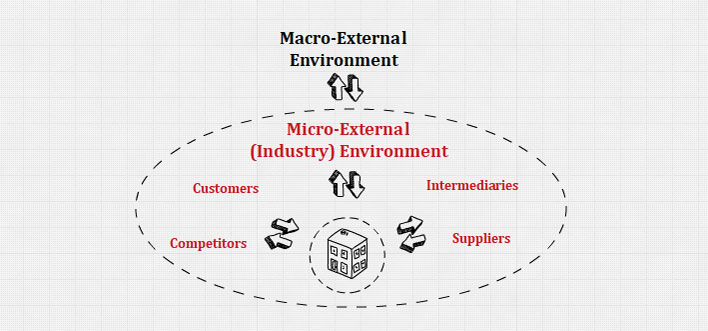
Competitive forces shape competition in the industry in which a company is based.
The study of competitive forces gives insight into potential opportunities and threats confronting a firm. This understanding in turn identify strategies that will enable the firm to outperform its rivals.
Analysis of the competitive forces within a given industry allows the firm to determine the industry’s attractiveness in terms of the potential to earn average or above-average returns.
The most important task of this industry analysis is to determine the sources of similarities and differences among companies in an industry, and from there to work out the broad themes that underlie competition in an industry.
This analysis often reveals new opportunities to compete in an industry by developing new kinds of products and services to meet the needs of customers better. It can also reveal emerging threats that can be countered effectively by changing competitive strategies.
Effective analysis of industry competitive forces is a product of careful study and interpretation of data and information from multiple sources. Firms must prepare a wealth of industry-specific data for the purpose of analysis and better understanding an industry’s competitive realities.
There are several theories on how competition shapes an industry. In one of the most acknowledged theories, the industry structure is divided into 5 competitive forces.
To study industry and understand its competitive situation, firms should examine these 5 forces that affect the ability of firms to operate profitably within the given industry.
The 5 Competitive Forces Model in Brief
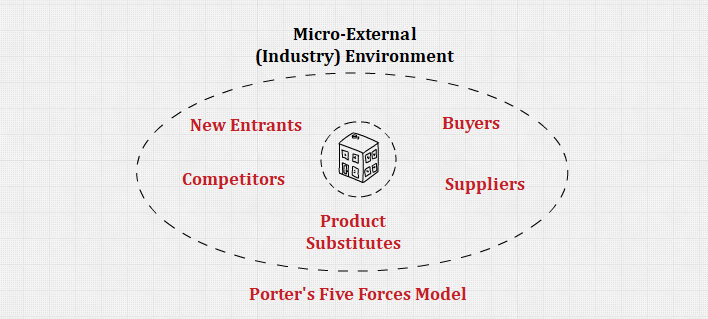
The 5 competitive forces are as follows: (1) threat of new entrants, (2) rivalry among existing firms, (3) threat of substitute products and services, (4) bargaining power of buyers, and (5) bargaining power of suppliers.
An unattractive industry has low entry barriers, suppliers and buyers with strong bargaining positions, strong competitive threats from product substitutes, and intense rivalry among competitors. These industry characteristics make it difficult for firms to achieve strategic competitiveness and earn above-average returns.
An attractive industry has high entry barriers, suppliers and buyers with little bargaining power, few competitive threats from product substitutes, and relatively moderate rivalry.
In short run, these competitive forces act as constraints on the organization’s activities. In long term, however, they may play an important role in creating advantages for the organization.
Each of these competitive forces can be rated as high, medium, or low in strength.
In general, the stronger the competitive forces, the lower the potential for firms to generate profits by implementing their strategies. A high force can be classified as a threat because it is most likely to reduce profits. A low force, in contrast, could be viewed as an opportunity because it may allow the organization to earn greater profits.
The intensity level of competition in an industry is high when competitive forces in that industry are in high strength. The intensity of competition among firms varies widely across industries. The intensity of competition is usually highest in lower-return industries.
These 5 competitive forces also expand the scope of a firm’s competitive analysis.
Historically, when studying the competitive environment, firms concentrated on companies with which they directly competed. However, modern firms must search more broadly to recognize current and potential competitors by identifying potential customers as well as the firms serving them.
In such an environment where businesses are interconnected, firms must study many other industries to identify companies with capabilities that might be the foundation for producing a good or a service that can compete against what they are producing.
When studying the industry environment, firms must also recognize that suppliers can become a firm’s competitors (by integrating forward) as can buyers (by integrating backward). In addition, firms choosing to enter a new market and those producing products that are adequate substitutes for existing products can become a company’s competitors.
Industry Life Cycle Affects Nature and Strength of Forces
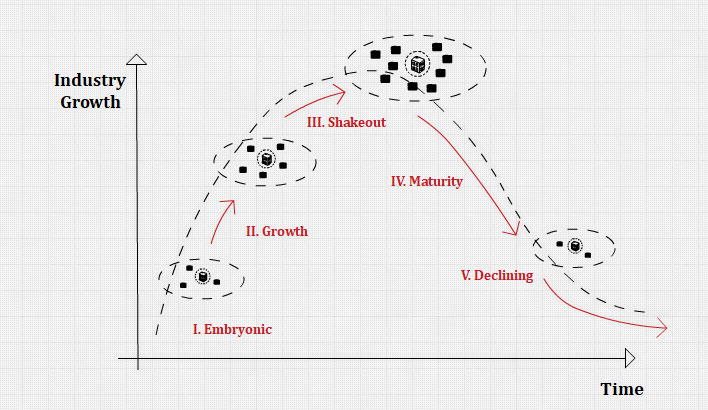
The industry life cycle model is used to analyze the effect of industry evolution on competitive forces.
It consists of 5 sequential stages of evolution of an industry that leads to 5 distinct kinds of industry environment: embryonic, growth, shakeout, mature, and decline.
Most industries evolve through all of these 5 stages.
The strength of each of the forces varies according to the current stage of industry evolution. Changes that take place during the industry life cycle are important determinants of the nature and strength of competitive forces. The nature and strength of each of the competitive forces change as an industry evolves, particularly (1) the threat of new entrants and (2) rivalry among existing firms.
In general, this industry life cycle is particularly useful for explaining and predicting emerging trends that drive industry competition.
Stage 1: Embryonic Industries
An embryonic industry is an industry that just begins to develop.
This industry is new and people purchase products and services regardless of price because they fulfill a unique need. Growth at this stage is slow because of buyers’ unfamiliarity with the industry’s product, high prices due to the inability of companies to reap any significant scale economies, and poorly developed distribution channels.
Barriers to entry tend to be based on access to key technological know-how rather than cost economies or brand loyalty. If the core know-how required to compete in the industry is complex and difficult to grasp, barriers to entry can be quite high, and established companies will be protected from potential competitors.
Rivalry in embryonic industries is based not so much on price as on educating customers, opening up distribution channels, and perfecting the design of the product. Such rivalry can be intense, and the company that is the first to solve design problems often has the opportunity to develop a significant market position.
An embryonic industry may also be the creation of one company’s innovative efforts. The company has a major opportunity to capitalize on the lack of rivalry and build a stronghold on the market.
Stage 2: Growth Industries
A growth industry is an industry where demand for products and services begins to take off.
In a growth industry, first-time demand is expanding rapidly as many new customers enter the market. An industry grows when customers become familiar with the products and services, prices fall because experience and scale economies have been attained, and distribution channels develop.
Normally, the importance of control over technological knowledge as a barrier to entry has diminished by the time an industry enters its growth stage.
Because few companies have yet achieved significant scale economies or built brand loyalty, other entry barriers tend to be relatively low as well, particularly early in the growth stage.
Thus, the threat from potential competitors generally is highest at this point. No firms absolutely dominate the market, with each firm only serves a small piece of the total market.
As new competitors enter the industry, prices start to drop as a result of competition. Companies use experience curves and economies of scale to reduce costs faster than competition, and further driving down costs by acquiring their suppliers and distributors.
High growth usually means that new entrants can be absorbed into an industry without a marked increase in the intensity of rivalry. Thus, rivalry tends to be relatively low. Rapid growth in demand enables companies to expand their revenues and profits without taking market share away from competitors.
A strategically aware company takes advantage of the relatively benign environment of the growth stage to prepare itself for the intense competition of the coming industry shakeout.
Stage 3: Industry Shakeout
An industry shakeout is an industry where the rate of growth has slowed, as explosive growth cannot be maintained indefinitely.
In this shakeout stage, demand approaches saturation levels: most of the demand is limited to replacement because there are few potential first-time buyers left.
As an industry enters the shakeout stage, rivalry between companies becomes intense. Typically, companies that have become accustomed to rapid growth continue to add capacity at rates consistent with past growth.
However, demand is no longer growing at historic rates, and the consequence is the emergence of excess productive capacity. Demand growth becomes slower as the industry becomes mature. However, capacity continues to grow. There comes an excess in capacity. In an attempt to use this capacity, companies often cut prices.
The result can be a price war, which drives many of the most inefficient companies into bankruptcy, which is enough to deter any new entry.
Stage 4: Mature Industries
A mature industry is an industry where the market is totally saturated, demand is limited primarily to replacement demand, and growth is low or zero.
Major growth in this industry stage comes from population expansion that brings new customers into the market or an increase in replacement demand.
As an industry enters maturity, barriers to entry increase, and the threat of entry from potential competitors decreases. Products tend to become commodities. This is now a consolidated industry dominated by a few large corporations, each tries to differentiate its products and services from those of competition.
As growth slows during the shakeout, companies can no longer maintain historic growth rates merely by holding on to their market share. Buyers become more sophisticated, price becomes a dominant concern, given a minimum level of quality and features, and profit margins start to decline. Competition for market share develops, driving down prices. Often the result is a price war.
To survive the shakeout, companies begin to focus on cost minimization and building brand loyalty. By the time an industry matures, the surviving companies are those that have brand loyalty and efficient low-cost operations.
Because both these factors constitute a significant barrier to entry, the threat of entry by potential competitors is greatly diminished. High entry barriers in mature industries give companies the opportunity to increase prices and profits.
Most industries in the maturity stage consolidate and become oligopolies. In mature industries, companies tend to recognize their interdependence and try to avoid price wars. Stable demand gives them the opportunity to enter into price leadership agreements.
The net effect is to reduce the threat of intense rivalry among established companies, thereby allowing greater profitability. Nevertheless, the stability of a mature industry is always threatened by further price wars.
Stage 5: Declining Industries
A declining industry is an industry where growth becomes negative for a variety of reasons, including technological substitution, social changes, demographics, and international competition.
As the industry progresses through maturity toward possible decline, its products’ growth rate of sales slows down and starts decreasing.
Within a declining industry, the degree of rivalry among established companies usually increases. Depending on the speed of the decline and the height of exit barriers, competitive pressures can become as fierce as in the shakeout stage.
The main problem in a declining industry is that falling demand leads to the emergence of excess capacity. In trying to use this capacity, companies begin to cut prices, thus sparking a price war.
Exit barriers play a part in adjusting excess capacity. The greater the exit barriers, the harder it is for companies to reduce capacity and the greater is the threat of severe price competition.
Strategic Types of Firms Competing in an Industry
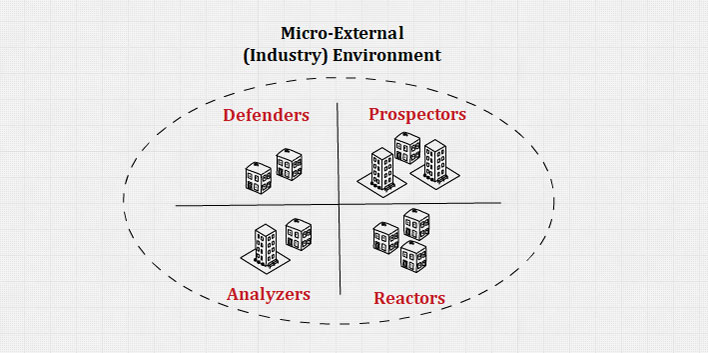
A strategic type is a category of firms that are classified based on a common strategic orientation and a combination of structure, culture, and processes consistent with that strategy.
This distinction also helps explain why some companies facing similar situations behave similarly, but differently from the rest of the firms in the industry, and why they would continue to do so over long periods of time.
Competing firms within a single industry can be categorized into 4 basic strategic types.
Strategic Type 1: Defenders
These are companies with limited product lines. They focus on improving the efficiency of their existing operations. This orientation makes them unlikely to innovate in new areas of the industry.
Strategic Type 2: Prospectors
These are companies with fairly broad product lines. They focus on product innovation and market opportunities. This orientation makes them somewhat inefficient as they tend to emphasize more on creativity.
Strategic Type 3: Analyzers
These are companies that operate in at least two different product-market areas, one stable and one variable. In stable areas, efficiency is emphasized. In the variable areas, innovation and creativity are emphasized.
Strategic Type 4: Reactors
These are companies that lack a consistent strategy-structure-culture relationship. Their response to environmental pressures tends to be piecemeal strategic changes only.
Strategic Groups of Firms Competing in an Industry
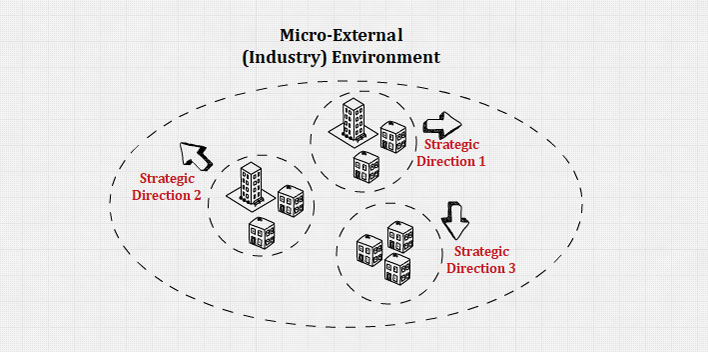
What Is a Strategic Group?
A strategic group is a set of business firms that pursue similar strategies with similar strategic dimensions and similar resources.
Some of the examples of strategic dimensions are distribution channels that firms use, the market segments they serve, the quality of their products, the extend of technological leadership, customer service, pricing policy, advertising policy, and promotions.
Companies in an industry often differ significantly from each other with respect to the way they strategically position their products and services in the market in terms of strategic dimensions. Thus, membership in a particular strategic group defines the essential characteristics of the firm’s strategy.
As a result of these differences, within most industries, it is possible to observe groups of companies in which each company follows a strategy that is similar to that pursued by other companies in the group, but different from the strategies followed by companies in other groups.
In the strategic group, products are close substitutes, rivalry has been high, and price competition has led to lower profits for this group as compared to companies in the proprietary group.
The competition between firms within a strategic group is greater and more intense than the competition between a member of a strategic group and companies outside that strategic group.
The performance leaders within groups are the ones that are able to follow strategies similar to those of other firms in the group and yet maintain strategic distinctiveness as a foundation for earning above-average returns.
Some strategic groups are more desirable than others because competitive forces open up greater opportunities and present fewer threats for those groups. Firms might identify a strategic group where competitive forces are weaker and higher profits can be made. Some strategic groups in the same industry are more profitable than others.
Why Is Strategic Group Important?
The notion of strategic groups can be useful in diagnosing (1) positioning, and (2) competition and profitability of firms competing within an industry.
First, each strategic group may face a different set of opportunities and threats, because they have a different standing position with respect to each of the competitive forces.
Categorizing firms in one industry into a set of strategic groups is very useful in understanding the competitive environment and analyzing competitive forces within that industry.
The strengths of the competitive forces differ across strategic groups, depending on the competitive positioning approach adopted by each strategic group in the industry.
In each strategic group, the risk of new entry by potential competitors, the degree of rivalry among companies within a group, the bargaining power of buyers, the bargaining power of suppliers, and the competitive force of substitute and complementary products can each be a relatively strong or weak competitive force.
Second, the most immediate threat to a company’s profitability comes from the competition of rivals within its own strategic group.
All the companies in a strategic group are pursuing similar business models, customers tend to view the products of such enterprises as direct substitutes for each other. Thus, a company’s closest competitors are those in its strategic group, not those in other strategic groups in the industry.
Firms within a group offer similar products and services to the same customers. Therefore, the competitive rivalry among them can be intense. The more intense the rivalry, the greater the threat to each firm’s profitability.
Mobility Barriers
Mobility barriers are within-industry factors that inhibit the movement of companies between strategic groups. They include the barriers to entry into a group and the barriers to exit from a company’s existing group.
The movement of firms from one strategic group to another is limited by high mobility barriers.
Firms may be tempted to change their business models and move to strategic groups with a low competitive environment. However, taking advantage of this opportunity may be difficult because of mobility barriers between strategic groups.
Over time, companies in different groups develop different cost structures and skills, and competencies that give them different pricing options and choices.
A company contemplating entry into another strategic group must evaluate whether it has the ability to imitate, and indeed outperform, its potential competitors in that strategic group.
However, after strategic groups are formed, their membership remains relatively stable over time.
How to Determine Strategic Groups
Using strategic groups to understand an industry’s competitive structure requires the firm to plot companies’ competitive actions and responses along strategic dimensions such as pricing decisions, product quality, distribution channels, and so forth.
This analysis can be done by plotting the strategic dimensions on a two-dimensional graph, using 2 specific strategic dimensions as vertical and horizontal axes.
The 2 strategic dimensions must differentiate the companies in one industry from another. These 2 dimensions must also not highly have correlated, otherwise, the map would provide little meaning other than something very obvious.
Firms can use this type of analysis to understand how certain companies are competing similarly in the industry, in terms of how they use similar strategic dimensions.
Resources
Further Reading
- What is Industry Analysis? (corporatefinanceinstitute.com)
- The Industry Environment Analysis (whatmakesagoodleader.com)
- Porter’s 5 Forces vs. PESTLE Analysis: What’s the Difference? (investopedia.com)
- Industry Analysis: What is Industry Analysis, Importance, Components, Forces and Example (businessmanagementideas.com)
Related Concepts
References
- Hitt, M. A., Ireland, D. R., & Hoskisson, R. E. (2016). Strategic Management: Concepts: Competitiveness and Globalization (12th ed.). Cengage Learning.
- Hitt, M. A., Ireland, D. R., & Hoskisson, R. E. (2019). Strategic Management: Concepts and Cases: Competitiveness and Globalization (MindTap Course List) (13th ed.). Cengage Learning.
- Hill, C. W. L., & Jones, G. R. (2011). Essentials of Strategic Management (Available Titles CourseMate) (3rd ed.). Cengage Learning.